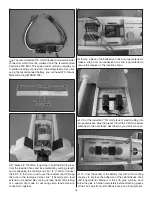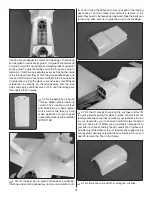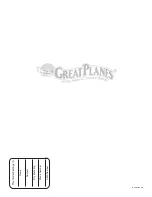
27
too much speed by the time you complete the turn. You will
cover less distance but you reduce your airspeed entering
the following straightaway dramatically. Making a turn too soft
and wide will take too much time to complete by covering too
much distance. Your turn exit speed will be higher but may
not be enough to offset the distance you covered making the
turn. The optimum turn is somewhere in the middle. Many of
the fastest racers set their elevator throws so that they pull
full elevator defl ection in each turn. If you have your rate set
right on the 3-pole course, you should be able to bank into
pylon 2 and smoothly pull elevator to full defl ection and end
up just clearing pylon 3.
The next step is to dial in the way the plane turns. What we’re
after is a plane that, when banked into a 90 degree bank for
a turn, it comes out of that turn still at a 90 degree bank and it
didn’t climb or descend. What we want is to make sure that the
plane fl ies “like” the weight is equal on both sides of the plane.
If you have one side of the plane that is heavier than the other,
the plane will roll some toward the heavy side when you pull
elevator and not stay at the bank angle you started the turn
with. I know we already talked about statically balancing the
plane and that will usually get you very close but, sometimes,
this roll is not simply caused by a weight difference but, you
can help correct it by adding weight to the side that is “acting”
like it’s lighter. To check for this condition you’ll want to fl y the
plane away from yourself so you can bank 90 degrees and
pull elevator to do a 180 degree turn back toward yourself. If
it does roll left or right, it will also climb or dive as it rolls. If it
rolls out of the turn and climbs, add weight to the lower wing. If
it descends and rolls into the turn, add weight to the top wing.
This will dramatically help with consistency of your laps and
your ability to control the altitude as you navigate the course.
Now, let’s trim the rudder. Of course, like aileron and elevator,
you want to trim for level fl ight with the plane not yawing left
or right. Now trim the rudder so that the plane is easy to
hold a constant altitude through the turns and is comfortable
holding that partial bank angle in the straights. Don’t add too
much and cause it to fl y tail low. You want just enough to get
the plane comfortable and not wanting to descend or climb
as you fl y the course.
Next we’ll dial in the way the plane fl ies in the straightaways.
This is going to depend on what course you’ll be fl ying, 2 or
3-pole and what length. In dedicated NMPRA EF-1 racing we
mostly use the 375 ft 3-pole course and 400 ft 2-pole course.
At some events where EF-1 is being fl own along with AMA
424 or 426 Q500 events the 475ft 3-pole course is used. On
the longer courses you will obviously spend more time in the
straights, making it more worthwhile to roll the wings closer
to level. On the shorter 375 ft 3-pole course, you’ll fi nd that
the faster way around the course will be to not roll all the way
out to wings level in the straights. Ideally, you would roll out
to a bank angle of approximately 45 to 80 degrees. When
viewed from above, your path around the three pole course
will look a lot like the shape of an egg with the course in the
straightaway’s being a gentle curve connecting the tighter
turns on each end. If you do it right, this will reduce the time
that you spend in each turn at a high elevator defl ection with
the additional drag that comes with it.
To understand adjusting the way the plane fl ies the straights,
you need to understand that a nose heavy plane will need
more up trim in the elevator to fl y level than a plane that has
the center of gravity further aft. We’re not talking about very
much difference, just a little. Maybe a few clicks of trim. So,
with a plane that is on the nose heavy side of the CG range,
the required up elevator trim will have an effect on the course
the plane will fl y when you bank the plane to say, a 45 degree
angle. That up elevator trim will then cause the plane to make
a gradual turn in the direction it is banked. The more forward
you have the CG, the more up elevator trim you need to fl y level.
The further aft the CG is, the less up elevator trim you need to
fl y level. So, when you bank a plane that has a further aft CG,
it will carry less elevator trim and consequently, it will make a
more gradual turn when simply banked to a given angle than
a plane that has a further forward CG carrying more up trim.
With this in mind, go fl y your Proud Bird on the race course.
When you exit a turn, roll to a 45 to 60 degree bank angle as
you enter the straight and ease off the elevator. If the plane
tends to drift too much toward pylon one before you want it
to, move the CG aft a little bit and go re-trim for level fl ight.
It will now drift toward the pylon less than it did before. If it
goes too straight for your fl ying style, move the CG forward
and re-trim for level fl ight. It will now drift slightly more in the
straights. The thing you have to keep in mind is, you may want
the CG in a different position for a longer course that has longer
straightaways. Usually, you will want the CG a little further aft
for a longer course to not curve the straights quite as much.
You need to keep in mind that, while you’re working through
these steps, you may fi nd that one adjustment has a small
effect on the other. That’s OK, just work with the different
adjustments we’ve discussed to fi nd a balance where all
of these factors work well together. Once you’ve completed
these steps, you’ll have a Proud Bird that will be easier to
fl y faster and more consistently than one where you have to
work harder to fl y well. These techniques apply to any pylon
racing plane and much of it to any plane you fl y.
You can continue to learn more by seeking out races and
racers in your area and get to know them. The NMPRA is a
great organization with a lot of members who enjoy helping
the new guy develop their skills and helping them enjoy the
thrill of pylon racing. As mentioned earlier, you can fi nd out
more at: www.nmpra.org.
Have fun and GOOD RACING!!!”
















